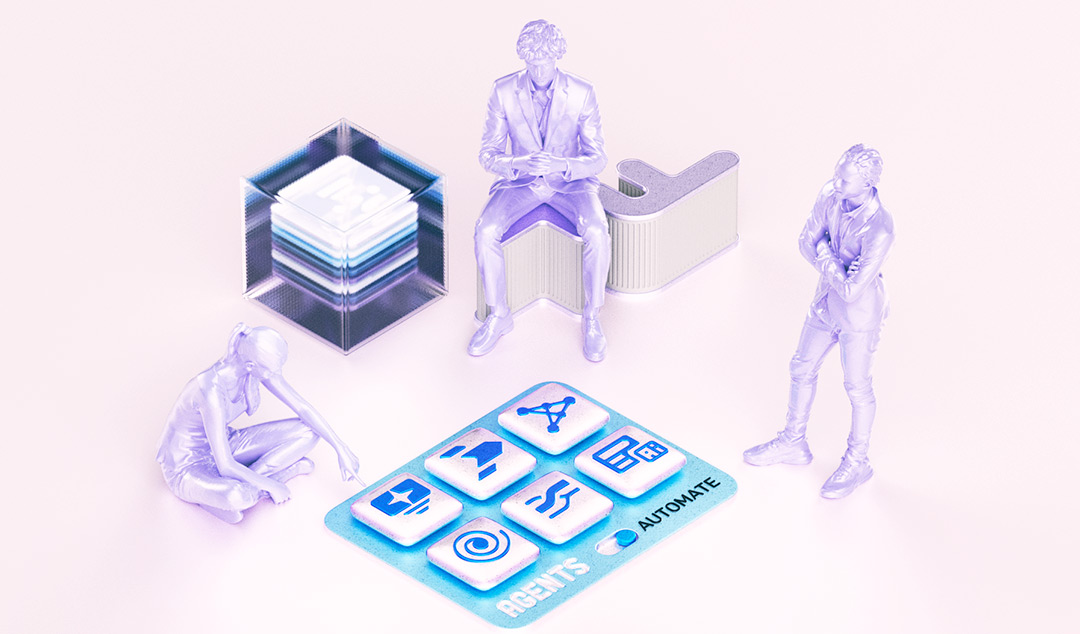Machine Learning Quality Assurance: Ensuring Reliable, Ethical & Performant Models
Discover how machine learning quality assurance ensures accuracy, fairness, and reliability in AI systems with best practices and tools. Read now!

Artificial intelligence (AI) and machine learning (ML) have long passed the hype associated with being “The Next Big Thing.” While they aren’t the science fiction futures that novelists once imagined – that may be a good thing – AI and ML are now doing hard, hands-on work in countless industries, from healthcare to manufacturing, agriculture, finance, cybersecurity, and far more.
These technologies are widely used in software quality assurance (QA) and testing. What started as early experiments with predictive defect detection and automated test generation has evolved into AI- and ML-powered testing pipelines. These systems continuously monitor performance, detect issues, and adjust to changes in the codebase in real time.
AI and ML are so useful for testing that some of the world’s biggest tech companies, including Facebook, Netflix, and eBay, have deployed them or launched pilots for using that purpose. eBay, as one example, developed a proof of concept to use ML to automatically detect flaws on eBay web pages.
There’s a good reason AI and ML have become so popular for QA and testing. Among the benefits is that AI and ML can speed up test creation, reduce test maintenance, and automatically generate tests. With the rise of large language models (LLMs) and generative AI (GenAI), QA teams now have tools that can understand natural language requirements, create self-healing tests, and even predict failures before they happen.
However, using AI and ML for QA and testing isn’t as simple as creating models, pressing a few buttons, and letting the technologies work on their own. These systems need careful training, validation, and oversight. There are many tasks these technologies can’t handle and several ways they can assist that you might not realize. In this blog post, we’ll look at what AI and ML do well in testing and where human expertise is still essential. Setting realistic expectations is the first step toward creating truly reliable, ethical, and effective testing models in the era of GenAI.
Why Quality Assurance Matters in Machine Learning
Quality assurance (QA) has always been the foundation of reliable software delivery; in machine learning (ML), the rules are different. Traditional software behaves as coded, while ML systems learn from data. This means their performance can change, decline, or act unpredictably if models aren’t thoroughly tested and watched closely.
In conventional QA, the focus is on functionality, performance, and detecting bugs. The results are predictable: the same input leads to the same output. In contrast, ML QA must consider factors like data quality, model accuracy, and even ethics. Since models change through training, a small issue in data or labeling can lead to significant errors once they are in use.
Testing ML systems requires a new approach. QA teams must check three layers: the dataset, the training process, and the model’s outputs, each under different conditions. QA doesn’t stop after deployment. Ongoing monitoring is vital to catch model drift, bias, and other unexpected behaviors that might arise over time.
Real-world consequences of QA failures
Even today, lapses in QA and testing can have serious consequences, especially as AI-powered systems get more complex and autonomous. Recent examples highlight the risks:
- Tesla’s Autopilot had multiple crashes between 2021 and 2024 due to issues in software and sensor testing, raising safety concerns for autonomous vehicles.
- Google Photos’ image classification system mis-tagged content, revealing biases and showing the need for thorough validation.
- Large language models, including ChatGPT, have produced false or misleading outputs, underscoring the challenge of ensuring accuracy in generative AI.
- Hiring systems aren’t exempt; Amazon discontinued an internal recruitment algorithm in 2022 after it favored male candidates, a direct result of biased training data and inadequate fairness testing.
These cases show that poor QA in modern AI systems can lead not just to technical and financial setbacks but also to ethical, social, and regulatory issues.
Integrating AI and ML with human smarts
Don’t make the mistake of thinking that AI and ML can completely take over QA. Testing isn’t going to be completely autonomous. Rather, those technologies should augment human testers and intelligence.
“For now, AI and ML aren’t able to completely replace the work of people,” says Eric Sargent, vice president of sales for Functionize. “Fundamentally, there's still no substitute for human understanding of the underlying intent of a test and expected behavior of an application, but AI and ML can certainly be powerful tools to fill in some of the key gaps of the testing process that have presented challenges for some time now.”
The key to using AI and ML, Sargent says, is to recognize their strengths and the gaps they can fill in QA and testing, and then use them to do only those things.
Core Dimensions of Machine Learning Quality Assurance
Machine learning quality assurance involves more than just testing code. It ensures models are reliable, fair, interpretable, and efficient. By focusing on key areas, teams can systematically spot risks, identify problems early, and maintain trust in AI systems.
Correctness & Accuracy
Models must provide outputs that accurately reflect real-world conditions. You can measure accuracy using statistical metrics like precision, recall, and F1 scores to ensure predictions or classifications match reality. Automated validation, sampling, and thorough data profiling help verify that the model’s outputs are meaningful and reliable.
Robustness & Stability
ML systems should stay robust and stable even when inputs or environments change. A model needs to handle edge cases effectively and maintain consistent performance across various scenarios. Continuous testing and monitoring help detect drift, unexpected behavior, or degradation.
Fairness, Bias, and Ethical Integrity
Models can pick up biases from training data or worsen existing inequalities if not monitored. QA processes should include bias detection, fairness checks, and strategies to ensure decisions are fair, inclusive, and comply with ethical and regulatory standards.
Interpretability & Explainability
Understanding why a model makes a certain decision is just as crucial as the decision itself. QA must evaluate whether stakeholders can explain and interpret outputs. This is vital for debugging, regulatory compliance, and building user trust, especially in fields like finance, healthcare, and autonomous systems.
Efficiency, Performance & Resource Constraints
QA ensures that ML systems run within acceptable limits for latency, memory, and computing resources. Measuring throughput, response times, and resource usage helps teams optimize deployment without sacrificing accuracy or reliability.
Security & Privacy
Data and models are at risk of attacks, misuse, or leaks. Measures like data anonymization, access controls, and adversarial testing help protect sensitive information and maintain compliance with privacy laws.
Maintainability & Monitoring Over Time
Lastly, QA extends past deployment. ML systems need ongoing monitoring and maintenance. Teams should track model performance, catch drift, and update models when necessary to avoid degradation. Version control, audit trails, and automated alerts ensure the system remains trustworthy and meets changing requirements.
Machine Learning QA Process Across the Lifecycle
Quality assurance in machine learning is an ongoing process that covers the whole model lifecycle. Each stage requires specific attention, from defining the needs to monitoring systems after they are deployed.
Key stages include:
- Requirements & Problem Domain Analysis
Define the business goals, success metrics, and ethical boundaries early. Collaborate with cross-functional teams from data science, QA, and the business domain to identify clear objectives that can be tested. - Data Quality & Pre-processing
Before training the model, ensure the data is valid, complete, and consistent. Spot and address bias, evaluate patterns with missing data, and confirm the data represents all user groups. - Model Design & Experimentation
Use reproducible testing through version-controlled experiments. Validate model assumptions, check robustness with synthetic or adversarial data, and integrate interpretability tools like SHAP or LIME. - Testing Before Deployment
Perform regression, load, and scenario-based testing to simulate real-world conditions. Test the system and model for correctness, performance, and ethical integrity with different levels of input and stress. - Deployment & Integration (MLOps / CI/CD)
Automate testing and validation pipelines. Integrate QA into CI/CD workflows with rollback mechanisms and drift detection to prevent degraded performance during model updates. - Monitoring & Feedback Post-Deployment
Regularly check for data drift, model decline, and unusual output patterns. Collect feedback from end users, log errors, and retrain models to handle additional errors, if needed.
ML Specific Tools, Frameworks & Technologies
Ensuring quality in machine learning requires more than traditional testing methods. To succeed, teams need the right combination of tools and frameworks that include automation, AI, and human oversight.
Functionize leads with its AI-powered Digital Workers. These specialized agents manage end-to-end test automation, fix broken tests, and adjust to changes in your application without much manual input. With Functionize, teams can:
- Create tests quickly without extensive coding knowledge.
- Run parallel tests across different browsers and environments.
- Keep test suites up to date with minimal effort using AI-driven maintenance.
- Automatically document and share results with stakeholders.
Functionize’s platform not only automates but also learns. Its AI agents act like human testers, shorten maintenance cycles, and allow engineers to focus on more valuable tasks, leading to faster and more reliable releases.
Platforms like ACCELQ Autopilot, TestCollab QA Copilot, LambdaTest KaneAI, and Tricentis Copilot also use advanced AI models to examine code and data. They create diverse testing scenarios that reveal bugs early. These tools use generative AI to:
- Automatically create and expand test cases based on system behavior.
- Identify potential failure points and suggest specific tests.
- Improve regression testing with realistic, synthetic data scenarios.
In short, modern ML QA relies on a hybrid approach: AI to automate and predict, humans to interpret and validate, and platforms to orchestrate it all. The right combination ensures higher quality, faster delivery, and more trustworthy AI systems.
Machine Learning QA Use Cases & Case Studies
AI is transforming the way we approach software testing, particularly in machine learning. Today, QA teams can rely on innovative tools that automate repetitive work and surface valuable insights, allowing humans to focus on more complex, high-value tasks.
Large language models like ChatGPT are already making an impact in QA. They can:
- Generate adversarial test cases to uncover edge-case failures.
- Summarize logs and highlight anomalies, saving teams from digging through mountains of data.
- Automatically produce documentation and model cards, keeping teams compliant and informed without extra effort.
Visual testing is another area where ML shines. Sargent explains it well:
“I remember as a kid looking at the Sunday comics. There was usually a game that would show three pictures and ask which is different. You’d scratch your head. After a while, you’d see that one drawing had some minute difference, such an extra freckle, and the other two didn’t. That's an oversimplification of the challenge, but generally humans are not all that adept at quickly working through complex comparative exercises. Give a machine the right kind of parameters however, it comes up with the answers much faster.”
eBay’s proof of concept using AI and ML backs that up. Using mockups of one of the site’s home page modules, the project first created 10,000 different images of the page that included different types of defects, including incorrect images, text, and layouts. It then used those images to train a model with ML to discover defects. Once the model was complete, eBay used it to check many different copies of the page for errors. The model had a 97% accuracy rate in finding defects.

Among many benefits, eBay says in its paper, is this: “A new eBay intern was able to ramp up in a matter of a day or two and start generating test data when training a ML model. Previously, some [quality engineering] teams would require a few weeks of daily work in order to become familiar with the domain’s specifics and the intricate knowledge of our webpages.”
Say what you want the test to do
AI and ML can also make it much easier for humans to build tests. They can allow testers to use plain English to describe the test they want to create. Behind the scenes, AI and ML do the work of translating that request into a fully-functioning test. So rather than write test code, a tester can write, “Verify that all currency amounts display with a currency symbol,” and a test is created to accomplish that. Making this even more powerful is that AI and ML can combine multiple plain English statements to build lengthy, complicated tests.
AI and ML can also outperform humans at doing root cause analysis. They can much more easily break down the sequences of events in an error in an application, and pinpoint exactly where there are coding issues. For example, they can recognize that whenever a specific data variable is inserted, a failure occurs five to ten steps later.
Used properly, AI and ML can also do an excellent job at regression testing. “As applications become more complex and release cycles accelerate it's simply not possible for humans to effectively keep up with the demands of running and maintaining their regression tests,” Sargent says, “Automation takes some of the burden off of execution. But by incorporating AI and ML, tests become more adaptable to minor changes. They self-correct or ‘self-heal’ as necessary. That task could take hours for a human to complete, as they work through triage of a failed test.”
Facebook has used ML in a unique way for regression testing: ML determines which regression tests should be used for any particular code change. Doing so cuts down on the number of regression tests that need to be run. The company says with ML, it only needs to run “a small subset of tests in order to reliably detect faulty changes...enabling us to catch more than 99.9 percent of all regressions before they are visible to other engineers in the trunk code, while running just a third of all tests that transitively depend on modified code. This has allowed us to double the efficiency of our testing infrastructure.”
Overall, Sargent says, AI and ML excel at the debugging process when you need to “parse out the code and figure out where the steps failed. Where AI and ML help most is in how much capacity they have for processing and calculating, and they take it much further than traditional automation.”
Just as important as knowing when to use AI and ML is knowing when not to use it. They don’t do well at exploratory testing scenarios and similar tasks that require unique human thinking, Sargent says.
“We, right now, are living in a world of narrow intelligence when it comes to AI and ML,” Sargent explains. “That means AI and ML are only as smart as the data they’ve been given and the parameters and the rules they’ve been provided with. Any sort of application or scenario where there's need for a dynamic outcome that isn't easily programmable is just not practical at this stage. Ultimately, the more dynamic and changeable the scenarios and standards you’re using, the more difficulty AI and ML will have making the best decisions.”
Still, Sargent says, when AI and ML are used for what they’re best at, they can evaluate failures quickly, fix them, and re-enter the code into the pipeline.
“That eliminates many of the bottlenecks many organizations are facing today when trying to shorten release cycles” Sargent says. “So using AI and ML makes a lot of sense — as long as you use it for the tasks for which it’s best suited.”
Following the execution of any functional test, Functionize provides extensive performance insights—without any additional steps. Read the white paper.
The takeaway? ML QA isn’t just about running checks anymore. With AI and GenAI tools, testing becomes smarter, faster, and more adaptive. Teams can focus on high-value work, catch tricky issues earlier, and deliver better software, faster.
Checklist of QA best practices
To achieve and maintain a high bar in Quality Assurance (QA), it requires a good mix of methods, tools, and processes. QA is all about efficiency, thoroughness, and trusting your process. Here is a helpful checklist to ensure your software testing is efficient, thorough, and trusted.
1. Balance automated and manual testing
A robust Quality Assurance (QA) methodology has a mix of automated and manual testing. Automated tests are great for repetitive tasks, such as performance, white-box, and regression testing. Manual testing will always play a role in Quality Assurance (QA), particularly in exploratory, usability, or ad hoc testing. A balanced mix will account for all areas of QA and provide the tester with meaningful comments on the user experience.
2. Embrace Agile workflows
Usually, QA is more effective when working in episodes of value delivery that are short and iterative. In a full delivery team, designers, developers, QA, and sometimes users collaborate in proximity as features are built and tested. Automation can be used to ensure the delivery cycle is fast, but do not skip any manual testing for usability or experience during the testing process. Feedback should be sought early.
3. Write clear, cohesive test cases
Every test case should focus on one feature or functionality while also linking to the overall test suite. Test cases should be straightforward; use a methodology that promotes test case usability, such as short, step-by-step descriptions with expected outcomes. Make sure your descriptions and instructions are clear so they are followed precisely. If possible, avoid testing in the coding environment while executing tests to avoid influencing the outcomes.
4. Integrate CI/CD
Continuous integration (CI) keeps code centralized, with small updates tested frequently. Continuous delivery (CD) allows rapid release of new versions, incorporating user feedback quickly. Together, they ensure code changes are tested thoroughly and released efficiently.
5. Prioritize communication
Testing isn’t just a QA task, it’s a team effort. Keep everyone informed about test plans, outcomes, and issues. Strong communication reduces risk, ensures smoother workflows, and aligns teams on quality objectives.
6. Focus on security
Testing should include security checks like penetration testing. Think like an attacker to identify vulnerabilities before real threats do. Proactive security testing strengthens software resilience and protects user data.
7. Choose the right tools
There’s no shortage of QA tools, but pick those that fit your workflow, budget, and scale. Integration with your existing platforms like Jira, GitHub, Azure DevOps, or Trello can save time and improve collaboration. Tools like Global App Testing (GAT) combine crowdtesting and automation for flexible, scalable QA.
8. Leverage crowdtesting
Accessing a global pool of testers can accelerate testing and cover diverse devices, browsers, and operating systems. Crowdtesting complements in-house manual and automated tests for broader coverage and faster results.
9. Follow core QA best practices
- Focused testing: Test one aspect at a time with clear objectives.
- Understand test types: Know when to use load testing, UAT, regression, and more.
- Regression testing: Retest key features after code updates to catch unintended issues.
- Bug reporting and tracking: Use a structured approach to report, track, and resolve defects.
- Use analytics: Track QA metrics to identify bug-prone areas and improve tests.
- Consider test environments: Run tests across different devices, OS versions, and user profiles.
- Unit and integration tests: Check individual components first, then verify how they work together.
- UI testing: Conduct human-led functional tests to ensure end-to-end scenarios perform as expected.
Challenges & Trade-offs in Machine Learning QA
QA for machine learning has its own unique set of challenges. Even skilled QA engineers often need to learn ML concepts to test models effectively. Understanding how algorithms work, what data they use, and how predictions are made is essential for meaningful QA.

Collaboration is important. QA teams and ML engineers need to start working together early in the project. This ensures that testing strategies match development workflows, model iterability, and project goals. Early planning lets teams choose supported devices, define performance expectations, and find the best debugging tools.
Another challenge is creating a fast and efficient feedback loop. Machine learning models change quickly, and QA needs to test, report issues, and validate fixes without delaying development. This requires careful coordination between data scientists and QA specialists to improve model performance while keeping reliability and quality.
In short, ML QA is about closing knowledge gaps, matching workflows, and creating strategies that keep up with rapidly changing models. Getting this right is critical for delivering trustworthy, high-performing AI systems.
FAQs on Machine Learning Quality Assurance
What’s the difference between traditional software QA and ML QA?
Traditional QA tests aim at predictable, rule-based systems with fixed inputs and outputs. ML QA focuses on models that learn from data, so outputs can change. Testing ML involves checking model behavior, data quality, and predictions. AI and GenAI tools can generate adversarial test cases, summarize logs, and support human oversight.
How can I detect and mitigate bias in ML models?
Bias often stems from unbalanced or skewed training data. QA teams can use ML-driven tools to spot anomalies, simulate edge cases, and highlight biased predictions. Reducing bias includes retraining with balanced data, applying fairness rules, and monitoring performance over time. Early collaboration between QA and ML engineers is important.
What trade-offs exist between model performance, interpretability, and resource costs?
High-performing ML models often require more data, computing power, and time, while simpler models are easier to explain but less accurate. QA teams need to balance accuracy, interpretability, cost, and testing effort. CI/CD pipelines with AI-assisted testing can help maintain quality without excessive overhead.
Conclusion
- AI and ML aren’t a replacement for human testers but powerful tools to augment QA, handling repetitive tasks and uncovering tricky edge cases.
- Early collaboration between QA teams and ML engineers is critical for effective testing strategies and fast feedback loops.
- Modern ML QA goes beyond code—it validates data, model behavior, fairness, performance, and ethical integrity.
- Automation, crowdtesting, and GenAI tools speed up test creation, regression checks, and anomaly detection without sacrificing quality.
- Continuous monitoring post-deployment ensures models remain accurate, reliable, and free from bias or drift over time.
- Clear communication, proper tooling, and structured processes help teams deliver software that’s secure, performant, and user-friendly.
- Ultimately, ML QA is a balance of human expertise and intelligent automation, ensuring faster, safer, and more trustworthy AI systems.











